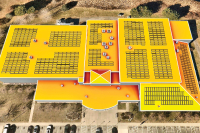Peak peeking
 The deluge we slogged through a couple of weeks ago certainly didn’t help this fall’s color palette. But not to worry, there’s still plenty to see. I made a short trip up the Blue Ridge Parkway from U.S. 23/74 to Richland Balsam to see what was happening — and it’s happening. Looks to me like this weekend will likely be peak for elevations between 3,500 feet and 4,500 feet. There is already a lot of steel grey above that, but it’s the middle of October.
The deluge we slogged through a couple of weeks ago certainly didn’t help this fall’s color palette. But not to worry, there’s still plenty to see. I made a short trip up the Blue Ridge Parkway from U.S. 23/74 to Richland Balsam to see what was happening — and it’s happening. Looks to me like this weekend will likely be peak for elevations between 3,500 feet and 4,500 feet. There is already a lot of steel grey above that, but it’s the middle of October.
I was pleasantly surprised to see a good deal of red. We haven’t had (to my knowledge) many of those crisp cool nights followed by sunshine — a process that turns the sugars trapped in the leaves into anthocyanin, producing the red color. Red and sugar maples, oaks, sumacs, dogwoods, sassafras and sourwoods commonly produce red color of various shades and hues.
There are countless factors that come into play to create all this fetching autumn color. Climatic conditions, soil type, the physiology of the species and even the health of the particular plant all play a part, and it’s possible to see a golden yellow red maple standing just a feet away from a scarlet red, red maple.
But one tree seems to be consistently red, and that’s the sourwood. It seems the reason for this is the sourwood’s autumn or annual leaf “senescence” (that’s when the leaf stops producing chlorophyll; the abscission layer forms and the tree drops the leaf) begins earlier than most trees and the sun gets to work on those sugars. You can almost always count on sourwood to produce deep red to maroon color every fall.
Some species that commonly produce yellow to orange color in the fall include silver maple, beech, basswood, tulip poplar and the hickories. I really love seeing the golden/orange of hickories every autumn.
To see all this color you need to get outside. And, truthfully, as long as you’re outside and open to it — you’ll find color everywhere right now — on the way to the post office; going for a run; and/or headed to car line. But to immerse yourself you might want to make a little more effort.
Related Items
No doubt the Blue Ridge Parkway is the default leaf-lookers’ tour in Western North Carolina. And for good reason. It can put you up close and personal with striking individual specimens of color along the road shoulder, or it can give you miles of vista across undulating carpets of color. Plus it’s ever-changing; a pull-off on one side of the road will show mountainsides bathed in golden sunlight while a pull-off on the other side will show color peeking from shady crevices. You might drive through fog for 20 minutes, where the hickories glow like candlelight, then suddenly pop out to see a sourwood blazing in the sunlight.
If you want to get off the Parkway, here is a drive that I have recommended for years — you can do the whole drive or amend it to fit your schedule and/or location: Take U.S. 276 from Waynesville to Bethel and pick up N.C. 215. Drive N.C. 215 through Shining Rock Wilderness and across the Blue Ridge Parkway. After the Parkway, N.C. 215 is a windy, high-elevation drive until it starts to fall down toward Rosman and U.S. 64. From N.C. 215 you get a good view of Roy Taylor Forest to the southwest.
At Rosman, take U.S. 64 West through Sapphire Valley to Cashiers and on to Highlands. You will be immersed in color. Continue on U.S. 64 West from Highlands through the Cullasaja Gorge to Franklin. The gorge provides spectacular scenery.
In Franklin, pick up U.S. 441 North to Dillsboro. The drive out of Franklin may start out a little boring, but the Cowee Mountains are sure to spice it up.
At Dillsboro you will pick up U.S. 23/74 East back to Waynesville. If you drive this road often, you may not pay a lot of attention. But coming from Sylva, the Balsam Mountains provide outstanding vistas during peak color.
(Don Hendershot is a writer and naturalist. He can be reached a This email address is being protected from spambots. You need JavaScript enabled to view it..)









